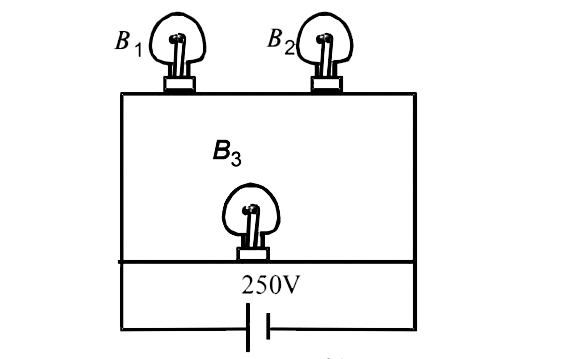2 V, 1 V और 4 V की क्रमशः 4Ω,3Ω और 2Ω आन्तरिक प्रतिरोधों वाली बैटरियाँ, समान्तर क्रम में जोड़ी गई हैं। प्रत्येक सेल में से बहने वाली धारा निकालें।
Text Solution
तीन बैटरियाँ A, B और C चित्र 6 . 21 में दिखाए अनुसार जोड़ी गई हैं।
किरखोफ के पहले नियम से
l1+l2+l3=0
या l3=−(l1+l2) . . . (i)
बन्द लूपों XBYAX और XCYBX पर किरखोफ का दूसरा नियम लगाते हुए हम प्राप्त करते हैं
−3l2+4l1=−1+2=1 . . . (ii)
और −2l3+3l2=−4+1=−3 . . . (iii)
समीकरण (i) और (iii) से
2(l1+l2)+3l2=−3
या 2l1+5l2=−3 . . . (iv)
स्पष्टतः , समीकरण (iii)−2× समीकरण (iv) से हमें मिलता है
−13l2=7
या l2=−(713)A
समीकरण (iv) से
2l1+5(−713)=−3
या l1=12(−3+3513)=−(213)A
समीकरण से (i) से
l3=−(l1+l2)=−(−213−713)=913A

|
Topper's Solved these Questions
- विद्युत परिपथ , विद्युत ऊर्जा और शक्ति BOOK - GRB PUBLICATION HINDICHAPTER - विद्युत परिपथ , विद्युत ऊर्जा और शक्ति EXERCISE - उच्चस्तरीय चिंतन : प्रश्नोत्तरी
9 Videos
- विद्युत परिपथ , विद्युत ऊर्जा और शक्ति BOOK - GRB PUBLICATION HINDICHAPTER - विद्युत परिपथ , विद्युत ऊर्जा और शक्ति EXERCISE - प्रश्नोत्तरी : 1 अंक
18 Videos
- विद्युत परिपथ , विद्युत ऊर्जा और शक्ति BOOK - GRB PUBLICATION HINDICHAPTER - विद्युत परिपथ , विद्युत ऊर्जा और शक्ति EXERCISE - प्रतियोगिता सामग्री ( रिक्त स्थान भरना )
15 Videos
- प्रत्यावर्ती धाराएँ BOOK - GRB PUBLICATION HINDICHAPTER - प्रत्यावर्ती धाराएँ EXERCISE - रिक्त स्थान भरना
15 Videos
- वैद्युत क्षेत्र और गाउस नियमBOOK - GRB PUBLICATION HINDICHAPTER - वैद्युत क्षेत्र और गाउस नियमEXERCISE - NCERT पाठ्यपुस्तक अभ्यास : उत्तरो सहित
29 Videos
Similar Questions
Knowledge Check
The cell has an emf of 2V and the internal resistance of this cell is 0.1Ω, it is connected to resistance of 3.9Ω, the voltage across the cell will be
A1.95VB1.90VC0.50VD2.00VA 100 W bulb B1, and two 60 W bulb B2 and B3, are connected to a 250 V source, as shown in figure. Now W1,W2andW3 are the output powers of the bulbs B1,B2andB3, respectively. Then
 AW1>W2=W3BW1>W2>W3CW1<W2=W3DW1<W2<W3
AW1>W2=W3BW1>W2>W3CW1<W2=W3DW1<W2<W3
